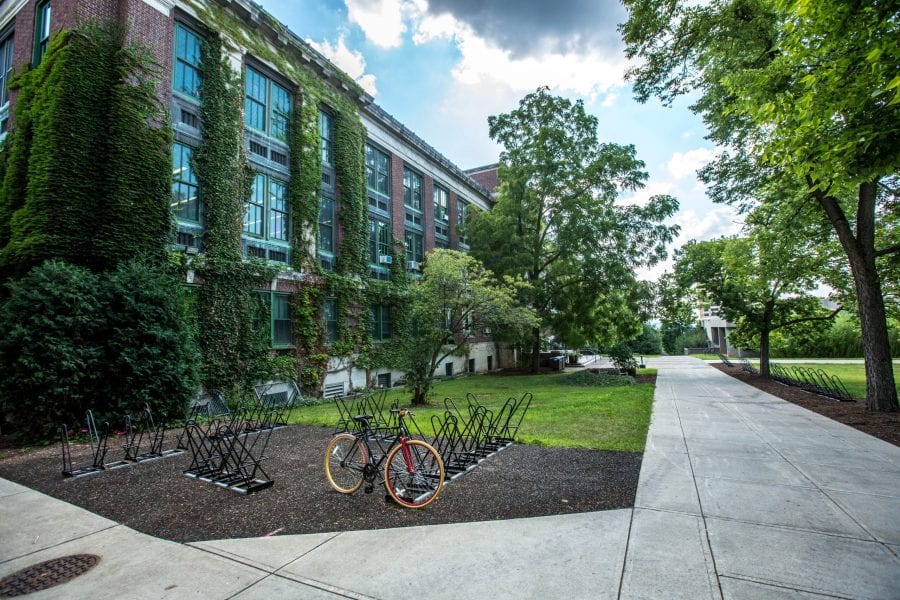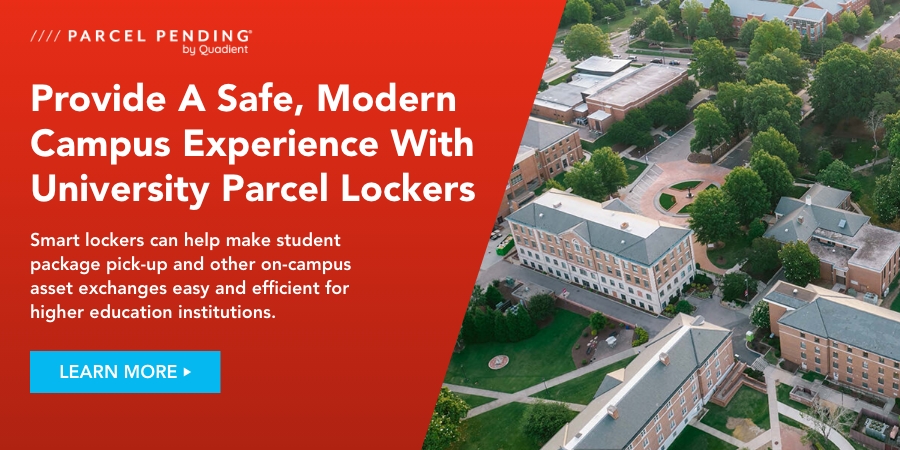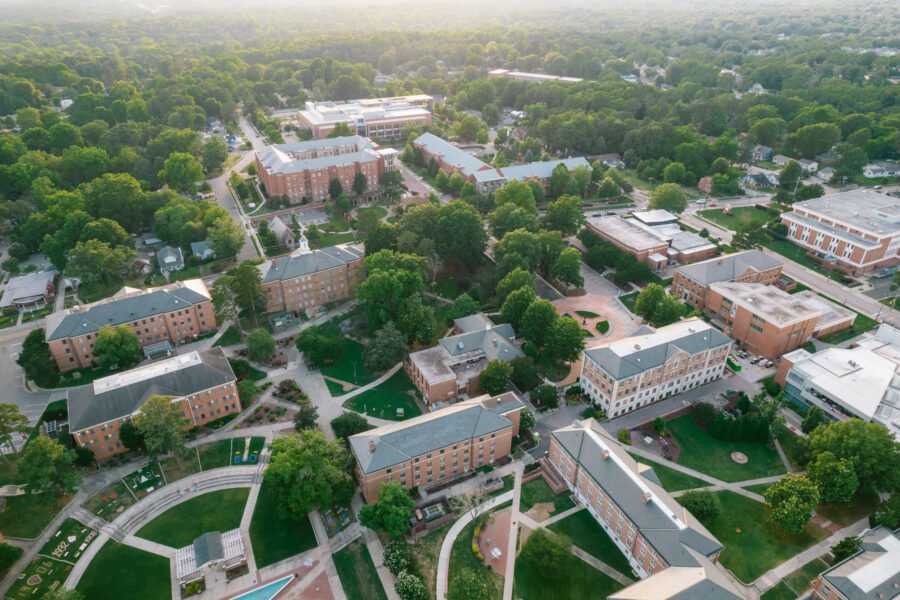
Our Blog
8 Ways to Improve College Campuses
Written by: Parcel Pending
10 Min Read
Published: April 10, 2019
Updated: February 4, 2024
Over the past few years, colleges and universities have been making significant investments on new campus facilities and other amenities in order to market themselves and draw in prospective students. Now, in light of the pandemic, higher education institutions face a new challenge: providing high-value amenities and facilities on college campuses despite budget constraints caused by lower enrollment numbers.
As competition for prospective students increases, college campus amenities that may seem expensive can become worthwhile investments made in response to consumer demand. In fact, industry experts like McKinsey recommend “providing fewer, better ancillary services, while keeping the broader well-being of [the school’s] students in mind.”1 But, for better or worse, students still care deeply about all aspects of their college experience, including the look, feel, and features of the campus itself.
If you are a college facility manager or auxiliary services manager, you likely hope that the main reason a prospective student would choose to attend your university is the world-class education your institution provides. However, while a school’s name recognition and academic reputation may pique their interest, the most significant selling point for many young people is the campus; i.e., the views, the dorms, the facilities, classrooms, amenities, and visual appeal.
It’s important to consider updating your college campus to help attract college students and keep existing students satisfied. That’s why we’re sharing eight of the best ways to improve college campuses.
Ways to Improve Your College Campus
While some colleges opt for more lavish amenities, choosing to invest time and effort in constructing plush, upscale college campus amenities (like building a lazy river), there are just as many who choose to invest in more practical campus facility upgrades.
While such distinctions and choices should be left up to an institution’s administrators and board members, a hefty price tag does not necessarily imply waste or excess. There are a wide variety of worthwhile campus facilities investments you can implement on a college campus that benefit the student population’s academic, emotional, and social development.
Turn the Gym into a Recreation Center
If you want to improve your college campus, one place that often goes overlooked is the fitness center. Thanks to education, social media, and the internet, the things college students want are much more in tune with the benefits of regular exercise and healthy living. As a result, many want a college campus equipped with a modern-day recreation facility, which provides a host of features and services.
In the past, a fitness center was most commonly in a campus building’s basement (typically in a residence hall) that contained weights, weight machines, and cardio machines. These days, recreational facilities can encompass a whole lot more than just the weight room.
If you want to improve your school’s gym consider adding:
- Training zones
- Plyometrics areas
- Sled training
- Incline training
- Rooms for classes such as:
- Yoga
- Martial arts
- Zumba
- Spinning
- Lap pools
- Basketball courts
- Sauna
Most modern recreation center facilities have sought to revolutionize the gym by not just focusing on physical health, but mental and social health as well. To that end, many rec centers also have social spaces where students can hang out, interact, and socialize. They also regularly contain health services centers, student counseling services, and sometimes even a wellness center. By combining various services in one place, a university can demonstrate that they care about both their student’s mental and physical well-being.
Keep the Campus Grounds Clean!
If you’ve ever been to a theme park, you have likely noticed how spotless the place is when it comes to trash, litter, or other spills. Even though thousands of people pass through these parks every day, the expectation that the park is “show ready” at any time has remained in effect. As a result, both custodians and park employees make a concerted effort to keep the park clean and “show ready” for its guests. The pride that theme park owners take in their park (or parks) is often passed down to employees, and together, they strive to keep the park beautiful so that everyone could have a special, memorable experience.
If you want to improve your campus, it is critical that you and the rest of the university employees exhibit similar care for your campus. If the landscape architecture and grounds are overgrown or the buildings are in disrepair, dated or dirty, both current and prospective students will not only take notice of it, but likely not care if they add to the mess that is already there. Keeping your campus clean will not only benefit the students but also help to improve employee satisfaction since an organized work environment is one of the most important factors when considering employee happiness.
Improve Campus Mail Services with Smart Parcel Lockers
Although students may not be receiving letters as often as they might have in the past, there are still a variety of trends on college campuses that impact the goods they will regularly receive including bills, checks, mail, magazines, care packages, or online purchases. Further, college students account for a significant portion of all online shopping done worldwide, which results in hundreds, if not thousands of packages that will have to be sent to the campus for pickup.
For students living on campus, this continuing deluge of mail can make picking up their deliveries from an “old school” mailroom or mail services center a massive pain. This experience can be further impacted by understaffing, inefficient retrieval methods, and limited pickup hours – all of which can lead to long lines and wait times.
As schools begin to figure out how to return to campus (without impacting campus safety or student health), campus mail services become even more important. In fact, recent research conducted by Parcel Pending by Quadient and Spaces4Learning revealed that 45% of college administrators would be interested in implementing parcel lockers as a campus amenity2.
Even making small updates to your university’s mail services can have a big impact on student satisfaction and help to improve staff efficiency. By updating your mail system to include smart parcel lockers, like those from Parcel Pending by Quadient, you can:
-
Reduce University Mailroom Operational Costs and Mitigate Risk
- Reduce package management labor resources by as much as a third
- Integrate with Quadient’s proprietary tracking software, WTS, or other existing university mail tracking systems
- Enable staff to focus on other important responsibilities
- Eliminate stale packages with robust reporting
- Reduce package liability and theft
- Have full chain-of-custody visibility for all packages and other goods delivered, so you know where students’ deliveries are at all times
-
Improve the Student, Staff, and Faculty Experience
- Make access and retrieval of packages quick and convenient for students, staff, and faculty – no need to worry about mail services operating hours
- Simplify parcel collection with automatic email or text notifications
- Ensure security and delivery accuracy
- Leverage a proven brand with the highest end-user satisfaction rating
-
Customize Your Campus
- Accommodate most delivery sizes and types
- Install indoors or outdoors depending on your campus’ unique needs and space requirements
- Brand your locker system with custom colors and wraps to match your university colors, mascots, or campus settings
- Secure deliveries with ATM-style, theft-proof steel for durability and longevity
- Ensure full system functionality with professional installation and maintenance
Now, higher education institutions can even leverage electronic locker solutions to centralize and track goods received and distributed across campus with our industry-first Campus Hub™ solution. Universities can leverage this solution to deliver goods including student mail and packages, tech equipment and accessories, library materials, campus store merchandise, food delivery from the dining hall, move-in and move-out materials and more.
Increase Parking
Students do not want to be forced to park on one side of the campus and then traverse to the other, lugging all of their books and other materials with them. Parking, or a lack thereof, is one of the most common complaints made by students at any given university.
While most universities seek to remedy this by simply discouraging underclassmen living on campus from bringing a car to school, if you have the space and the funds, it would be wise to build additional parking lots or turn existing lots into parking structures.
If increasing the supply of parking spots is not an option, consider taking the following actions to reduce the demand for parking spots:
- Create a direct bike path
- Add secure bike parking that provides shelter and security cameras
- Improve campus transit buses and trolleys by adding more pick up times and routes
- Switch from annual parking to daily parking
Create a Sustainable Student Farm
Many universities have created areas where students, staff, and faculty can grow and tend to produce (such as seasonal fruits and vegetables). If you have the room to set aside for such a space, it can provide numerous benefits to the campus including:
- Educating students – Students can learn basic farming techniques and gardening skills involved with organic food production, sustainable agriculture, and environmentally friendly practices.
- Feeding the campus – A sustainable farm can provide the student body with healthy, locally grown produce.
- Improving the world – A community garden can help young people learn the value of patience and hard work, as well as help them better appreciate nature.
Focus on Creating Spaces Where Students Can Come Together
While reading about important matters is a vital learning tool, lived experiences are also critical for a young person’s development. A student needs to be engaged during their time on campus – attending campus events like football games, hearing new music, and even experiencing new cultures, languages, and ideas. College students, especially, require common areas where they can gather, socialize, and engage in discussion, debate, and relationship building.
Universities are filled with different people from various backgrounds and you want to ensure you’ve set aside places where they can come together and build a cohesive university community in spite of their differences. Building residence halls, student centers, civic spaces, cultural spaces, music halls, and other such facilities can help funnel students together and grow the campus community.
These campus facilities encourage students to interact with others, stretch their intellectual horizons, and learn and grow as people. They also help transform the campus from being a place filled with individuals to a student body that is united by shared respect and university values. Although it is not a direct learning experience (such as in the classroom), socialization is almost as critical a learning component in the formation of well-rounded, responsible, contributing members of society.
Go Green
The younger generation cares deeply about their impact on the environment. Sustainability, recycling, and energy consumption matter to them. Many will be drawn in by a campus that mirrors their beliefs on the benefits of going green and provides them with the resources to do so. Universities that pave the way and take the initiative for creating a better, more sustainable future serve as role models for young people.
An easy way to improve your campus is by making a concerted effort to go green. Possible campus sustainability initiatives include:
- Retrofitting buildings’ heating and AC
- Employing solar technology (such as solar panels)
- Implementing or improving the recycling program on campus
- Changing to CFL or LED light bulbs
- Ditching textbooks and going digital
A campus-wide effort to reduce carbon emissions not only benefits the university, but the world as a whole.
Do Not Forget the Campus Tour
Every spring, hundreds of thousands of high school students go on a college tour with their parents or loved ones. On these trips, they will often visit several colleges back to back as a means of comparing and contrasting their options. This helps them get a feel for what they are looking for and answer questions like:
- Do I want to attend a big state school or small private university?
- Do I want to live on the east coast or the west coast?
- Could I envision myself spending four years here?
- Is my intended major or career path emphasized here?
- Is Greek life important to the school?
- Does the school’s athletics programs (such as football or basketball) matter?
- Do alumni stay involved?
While most every university offers tours, some understand the purpose of it better than others. This visit gives students a chance to see current students in action and get a sense of what campus life is like there. The tour guide should show prospective students around and help them imagine what their life would be like at that college.
It is critical that you create an engaging and interactive tour that really sells the university and highlights what sets it apart from the rest. If your facilities management team plans on making any of the improvements discussed above to your college campus, it is critical that you feature them in future college tours.
Improving Your Campus
All of the suggestions above are intended to either make student life more convenient, drive student interaction, or provide them with reasons to take pride in their university and what it represents. Whether it be adding smart parcel lockers, updating the recreational facility, or even adding a community garden, there are a variety of steps higher education institutions can take to improve your campus environment.
Remember: the improvements you choose to invest in don’t always have to cost an arm and a leg. They can be smart, affordable, and focused on improving efficiency.
Sources:
- Dua, André, et al. McKinsey & Company. Reimagining higher education in the United States. (2020, October 26). https://www.mckinsey.com/industries/public-and-social-sector/our-insights/reimagining-higher-education-in-the-united-states.
- Spaces4Learning & Parcel Pending by Quadient. (2020, December). Campus Operations During the Pandemic [White paper]. Retrieved from: https://spaces4learning.com/Whitepapers/2020/12/Campus-Operations-During-the-Pandemic.aspx






